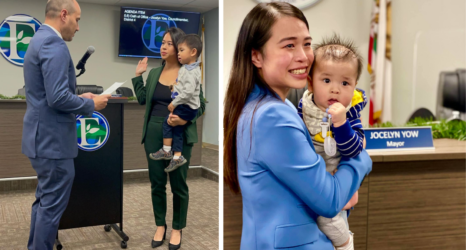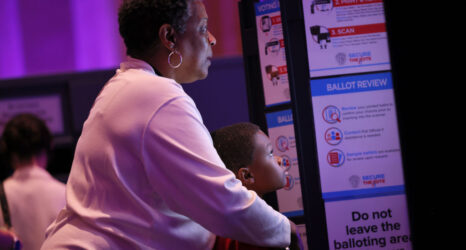Throughout the 2018 elections, Ms. brought you content presented in conjunction with Gender Watch 2018, a project of the Barbara Lee Family Foundation and the Center for American Women and Politics. Now that results are in, Gender Watch 2018 experts are offering additional insights and analysis into what happened.
In this year’s election, women scaled up their political representation—reaching a new high for the number of women in Congress and in state legislatures. In the 116th Congress that convenes in January 2019, women will hold at least 23.4 percent of all seats, up from 20 percent in 2018.
That isn’t enough.
“When [women] are really part of the discussion and the decision-making, our voices are distinct,” former Representative Donna Edwards (D-MD) told us in May 2016. “But we’re just not to scale. There’s just not enough of us, period.”
As long as women hold one seat for every three held by men, the reasonable expectation for gender parity in political officeholding remains unmet. The presence of more women—and, importantly, more diverse women—will make a difference in politics and policymaking.
The more reflective that our nation’s most visible policymaking body is of the population it is meant to serve, the more legitimacy it has as a truly representative institution. Texas, which has a statewide constituency that is close to 20 percent Latina, elected Latinas to the U.S. House for the first time this year. Four newly-elected women in Connecticut, Kansas, Massachusetts and Minnesota will become the first women of color to represent their states in Congress next year. These women will give voice to constituencies in their states and districts that previously had no seat at the table.
But legitimacy means more than matching population and representation statistics. For populations historically denied access to formal political power, including women, seeing themselves in our nation’s most powerful political institutions can induce greater trust in those institutions—and even inspire some to see political leadership as a possibility for themselves.
“In 230 years, there’s never been a Native American woman in Congress,” Deb Haaland told ABC News earlier this year. “I have never seen myself in that body of our government.” With her election to become one of the first Native American women in Congress, Haaland has made it possible for tribal women to see themselves in congressional leadership.
Even the women who were unsuccessful in 2018 likely had this effect on some voters. Many women candidates moved beyond disrupting the image of political leadership—challenging voters to think differently about what attributes they value in candidates and officeholders, rethink biases they’ve held about gender and race and candidacy, and consider the benefits of integrating women’s perspectives and experiences in political discourse and deliberation.
The women who will now hold political power will have an even greater opportunity to prove the worth of women’s inclusion to policymaking. Much of this work will be hard, if not impossible, to quantify. Adding more women to the legislature does not guarantee more legislation overall, or more specific types of legislation, will pass, especially in a highly polarized environment—though previous evidence suggests women’s legislative effectiveness is greater than men’s. And while many of the 83 congresswomen my colleagues and I interviewed for our new book, A Seat at the Table: Congresswomen’s Perspectives on Why Their Presence Matters, believed strongly that they are more willing to collaborate across party lines than many of their male counterparts, the decline in women’s representation among Republican women this year only further reduces the opportunities for bipartisanship.
So where might we expect to see the positive effects of women’s increased representation? Like former Representative Edwards, many women candidates and officeholders describe the ways in which their perspectives and experiences are distinct from those who have long held political power, and all too often missing in key policy conversations.
That’s especially true for the “firsts.” As Senator Tammy Baldwin (D-WI), the first openly gay or lesbian person elected to the U.S. Senate, shared with us: “When you’re a first, you change the dynamic.” She elaborated that in all of history prior to her presence in the Senate, discussions about advancing or curbing civil rights for the LGBT community “have occurred in rooms without a voice from the LGBT community participating.” Now, Baldwin noted, “they’re happening in rooms where I’m present and can represent a perspective.”
In 2019, the first Native American and first Muslim women will sit in rooms where their perspectives have gone unrepresented to date. “I feel a tremendous need to be a voice,” Representative-elect Rashida Tlaib (D-MI), a Muslim and Palestinean American woman, told Forbes earlier this year, “for those that have not had a chance to be at the table on issues that directly impact our lives.”
Likewise, Representative-elect Sharice Davids (D-KS), who will be one of the first Native American women in Congress, offered a glimpse into how her distinct identities might shape her approach to policymaking. “Part of what we should be thinking about, whenever legislation is passed, is, ‘how does this affect all varieties of communities?’” she told the Washington Post. “When there are more voices at the table and people with different experiences, we will be better equipped to figure out who hasn’t been part of this conversation.”
That motivation to represent the voiceless is not unique to the women who are among the firsts in Congress. When we interviewed Representative Ann Wagner (R-MO) in 2016, she shared that her mission statement “talks about giving voice to the voiceless, and how important that is, and how we have to remember that’s why we’re put here in this legislative role.”
Across race, ethnicity and party lines, the voices of women in Congress, as well as the perspectives to which they give voice, are both diverse and distinct. The volume of those voices may be greater in 2019—but recognizing the value-added of women’s representation should only spur us to do more to achieve gender parity in our legislative institutions. Because, even in light of women’s gains this year, they are still not to scale.





